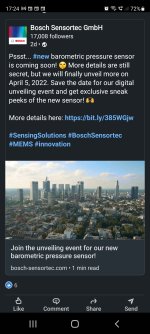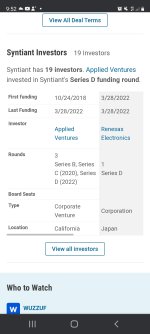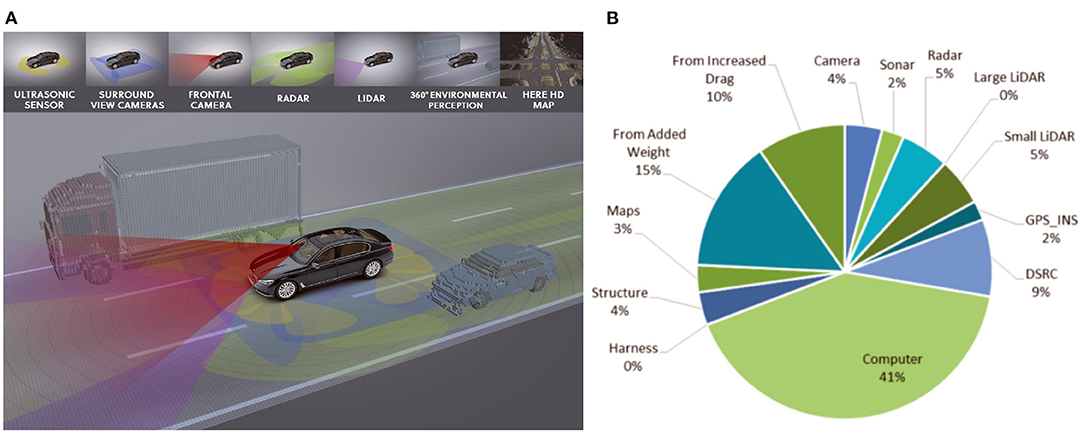Sorry the link to the Valeo rep at Auto Sens in May, 2022 will not cooperate but it is an easy Google. The following article teaser about Radar is interesting implementing Ai with Radar is apparently the hot topic and that is what BRN, ISL & the US Airforce are doing. Funny that:


Predicting the future of RADAR, the ‘magic’ sensor
RADAR is a regular theme at our AutoSens conferences and Detroit 2022 is no different. We caught up with a selection of experts joining us during the RADAR sessions at AutoSens in Detroit this May. Experts include Harvey Weinberg, Director of Sensor Technologies, Microtech Ventures who will be discussing “Automotive Radar: Next-Generation Technological Approaches and Applications”; Markus Willems, Senior Product Manager at Synopsys who will be exploring “Radar Digital Signal Processing Goes Floating Point” and Tony Gioutsos, Director Portfolio Development Autonomous Americas at Siemens who will be presenting “Key Features in Radar Simulation for ADAS/AV.”
Q: What interests you the most about recent RADAR developments?
HW: Considering that radar in general is almost 100 years old and automotive radar is over 50 years old, I find it fascinating that new developments continue to spring up. Even more interesting is that there is innovation happening in almost every part of the radar eco-system! Everything from highly integrated chipsets built to accommodate expansion, to novel antennas, to algorithms that improve angular resolution and coexistence.
TG: I am an old SAR imagery guy. We had some very fine resolution imagery (including azimuth) back in the 80’s. Finally, we are starting to see some finer azimuth resolution systems (obviously not SAR) that are making some progress in this area. I have been waiting for that!! Until, “4-D” radar is viable, I do not think a “real” level 4/5 will exist.
MW: It’s fascinating to see that RADAR finds its way into a wide range of applications, such as infotainment, smart homes, factory automation, to name a few. This goes hand in hand with the evolution of different sensors, which require evolutions on the signal processing side, too. With the RADAR sensor often being complemented by other sensors, the topic of sensor fusion will gain increasing importance.
Q: Out of the companies that are doing unconventional things with RADAR for automotive, which would you say was the most interesting and “one to watch” over the next three to five years?
TG: The two big ones for me are Uhnder and Vayyar.
HW: As far as “who is the one to watch” that’s almost an unfair question. Today radar is being used in so many novel areas in automotive (ground penetrating radar for vehicle localization or driver and passenger monitoring, for example) that it’s just not possible to pick one (or even two) hot players.
MW: It’s hard to single out a specific company. Combining classical RADAR signal processing with AI-based decision-making steps (e.g. replacing CFAR with Neural Network based approaches) is definitely a hot topic to watch for.
Q: There continues to be hype around LiDAR, do you think there will continue to be a place for RADAR if the current LiDAR challenges can be solved?
TG: Absolutely! Radar is a “magic” sensor. It can see things optical sensors cannot, especially in weather situations. Bottom line, as many sensors as possible will be needed for true level 4/5.
MW: Based on a lot of discussions with our customers, who are designing next-generation SoCs for automotive applications, I’m convinced that RADAR and optical sensors (camera & LiDAR) will co-exist. Thinking about the value of RADAR, it will allow to “see” what’s occluded in the optical range, can penetrate bad weather conditions, can be used for additional validation and improve accuracy (e.g. for target speed estimation).
Obviously, there is cost pressure, and there might be trends to reduce the number of sensors by more sophisticated signal processing. Again, AI-based approaches will play an important role.
HW: Regarding LIDAR versus radar: In almost every parameter one would care about in automotive, radar beats LIDAR hands down. It’s cheaper, has longer range, works better in bad weather and it’s easier to integrate in the car. However todays LIDAR beats even the best available (or soon to be available) automotive radar’s angular resolution by at least an order of magnitude. Often more.
Angular resolution is critical in enabling high-functionality ADAS and/or autonomous driving. To give one example, road debris – like a tire or a cement block in the road – is very hard for current radar systems to differentiate from the road surface. LIDAR does a much better job of this due to its high angular resolution. You must be able to see such a hazard from at least 100m away – under all lighting conditions – if you want to have reliable autonomous driving at highway speeds as you will approach that hazard in less than three seconds!
So, for at least the next few years, I don’t see radar displacing LIDAR. On the other hand, I don’t see LIDAR replacing radar ever, as radar has superior weather immunity. So for at least the next 5 to 10 years I expect to see both LIDAR and radar coexisting. After that the crystal ball gets foggier…
Q: What is holding back better simulation for radar?
TG: I think it is a question of getting correct measurement data for world objects. What that means is getting data for all incident angles with a vast array of material properties. This then must be correlated to the simulated world correctly using a smart approach to world modeling, sensor modeling and using a proper simulation engine (e.g. a uniquely designed ray-tracing engine)
Q: What are you looking forward to about joining us as a speaker at AutoSens in Detroit this May?
TG: AutoSens is my favorite conference. I mean engineers run it! I’ve been presenting, going, exhibiting, etc. since the first one! Going to be great to actually go to a conference again. It will be great….
HW: One of the things I’m most looking forward to about speaking at AutoSens is being at an actual, in-person, conference with a physical audience. On-line conferences have certainly been a godsend. They’ve allowed us to continue on despite the pandemic. But there is nothing like the dynamic of interaction between large numbers of smart people that you get at technical conferences. So many interesting questions and challenging discussions that are totally unexpected.
MW: First of all, it will be great to have face-to-face meetings again, this is something that all of us have missed a lot during the past two years.
I consider AutoSens to be an excellent venue to listen to latest innovations. And of course, I’m very much looking forward to inspiring discussions with prospects and customers.
If you are interested to learn more about RADAR,
why not pop along to an AutoSens conference this year was









